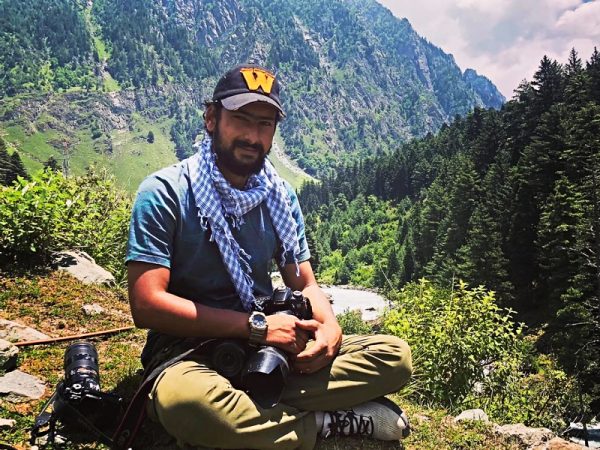
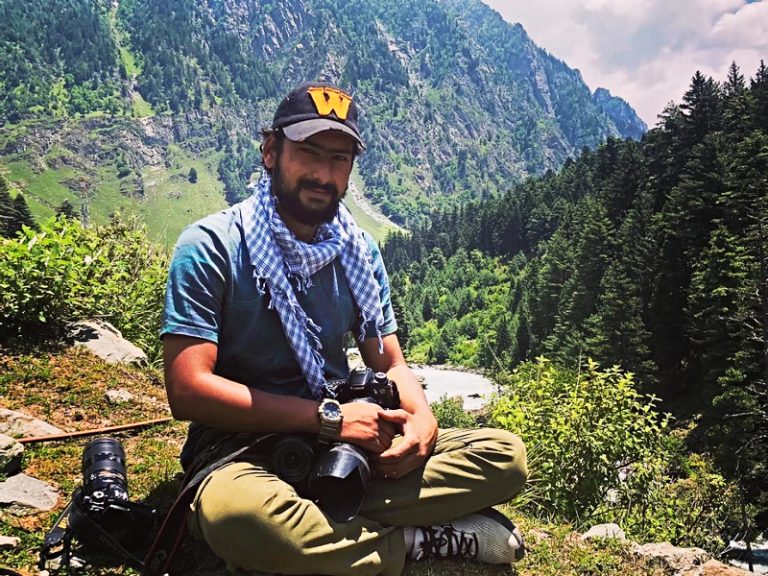
Bangalore: When photojournalist Kamran Yousuf, 25, was attacked and beaten by a group of policemen on 15 September 2020, while he was taking pictures in southern Kashmir’s Pulwama, the trauma of what he had undergone in the past came flooding back.
In 2017, Yousuf was booked under the Unlawful Activities Prevention Act, 1967 (UAPA). The National Investigation Agency’s (NIA) chargesheet explained why it thought Yousuf wasn’t a “real journalist”.
“He had never covered any developmental activity of any Government Department/Agency, any inauguration of Hospital, School Building, Road, Bridge, statement of political party in power or any other social/developmental activity by state government or Govt of India,” the NIA said.
Then 22, the photojournalist spent six months in Delhi’s Tihar Jail before the court examined his professional record, disagreed with the NIA and granted bail on 13 March 2018.
As the Supreme Court debates free speech and emphasizes the need for “fair journalists”, Kashmir’s press is grappling with more basic issues of personal safety and the right to report the facts. “We have to protect free speech. Equally, we have a constitutional duty to protect human dignity. That’s as equally important,” said D Y Justice Chandrachud.
Dignity has been in short supply this past year for journalists in Kashmir.
Srinagar-based journalist Auqib Javeed was slapped, threatened by the police after he wrote a story for Article 14 on police bullying Twitter users for “political” tweets, a reflection of the growing harassment of journalists. Despite the repeated assertion of the media and human-rights groups that “journalism is not a crime”, the profession has been defined differently in Kashmir.
On the second anniversary of the arrest of journalist Aasif Sultan, when Twitter users began sharing a full page advertisement issued in The Washington Post newspaper by the Committee to Protect Journalists (CPJ), the handle of the Jammu & Kashmir Police tweeted: “Aasif Sultan not booked for his Journalism but…hatching political conspiracy, harbouring & supporting terrorists who martyred a Police constable…”
Sultan’s friends and colleagues have dismissed these accusations, saying that it was his journalism that got him arrested. Less than two months before Sultan was arrested on 27 August 2018 he spoke to associates of Burhan Wani and revisited the 21-year-old militant’s meteoric rise around the time of his second death anniversary in a piece for Kashmir Narrator, where Sultan worked as assistant editor. He was charged with the UAPA; his next hearing is scheduled for 6 October 2020.
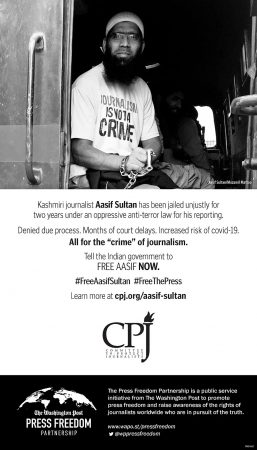
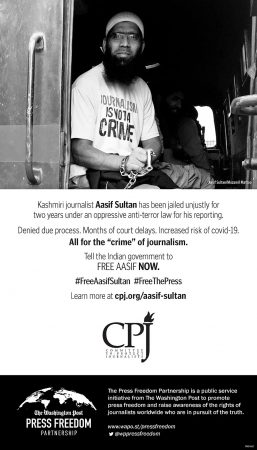 What Changed This Past Year
What Changed This Past Year
“Why don’t you do positive journalism?” a senior police officer asked independent journalist Safina Nabi recently.
It’s a line Kashmiri journalists have become familiar with since the abrogation of Article 370—the constitutional provision that merged the former kingdom of Jammu and Kashmir with India—on 5 August 2019. Another line journalists have heard often this past year: “Instructions have come from the top.”
Journalists were always under siege in Kashmir but something changed this past year.
The government amended India’s severe anti-terror law last year: individuals can now be declared terrorists and their properties seized. In recent months, the law has been widely used against student protestors, such as these two Jawaharlal Nehru University scholars.
“You’re no longer writing against the state government or some local sovereign government—you’re writing directly against the Centre,” said Zargar.
Confirmed Indian Express reporter Bashaarat Masood, “It’s becoming impossible to report from Kashmir.”
“One year has just vanished from our lives,” said Fahad Shah, founder of The Kashmir Walla, an independent magazine which recently launched a membership programme to keep itself afloat. Shah was on the verge of shutting down operations in November 2019 when funds ran out but, he said, in recent months he’s glad he changed his mind.
“These past 6-7 months I have realised it’s very important to keep this alive,” he said. “An independent platform is very important in Kashmir.”
In the conflict zone where news reporters have always battled great odds to share the first draft of history, this last year has been particularly difficult.
How Things Changed
On 2 June 2020, the rules for Kashmiri journalists were codified in a New Media Policy which, among other things, gave the government’s Information Department the right to decide whether or not a report constituted fake news and green lighted prosecution by the police.
The policy also introduced mandatory background checks for journalists. Kashmiri media—more than 1,000 registered titles—should have been up in arms, but instead there was silence. In Indian mainstream media, this news was barely acknowledged.
More than 10 days later, a lone editorial in the Kashmir Observer pleaded: Let Media Be.
“The local media with its exclusively Valley-centric focus has helped uncover the shades of the truth that have otherwise found little resonance in the larger Kashmir debate,” the editorial said. “The administration should therefore have let the media be.”
By then, the ground to do exactly the opposite had already been prepared.
In April 2020, three journalists faced police action within the span of 48 hours—two of them under the UAPA—for doing their job. The state defined what would be described as regular journalism in other parts of the country as “anti-national” and “glorifying terrorism”.
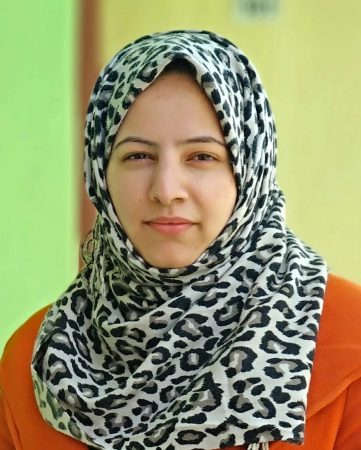
The neutering of mainstream media in Kashmir began a few months before the abrogation of Article 370.
Take the case of the biggest regional newspaper Greater Kashmir. In February 2019, government advertisements—the main source of the newspaper’s revenue—were abruptly stopped. In the weeks before 5 August, many of the newspaper’s columnists were first asked to modify columns and then discontinued. This piece in the Istanbul-based TRT World explains how the gag unfolded and how novelist Franz Kafka filled the void.
The censorship wasn’t just restricted to words.
In May 2019, Suhail H. Naqshbandi, the newspaper’s editorial cartoonist, announced on Twitter that he had quit his job because of “absurd” levels of interference. “The levels of censorship became stringent especially after February 2019 when the Information & Broadcasting Ministry asked the J&K administration to identify what they termed as “resistance art” coming out from Kashmir,” he said.
In July, editor Fayaz Kaloo was interrogated by the NIA, allegedly about articles on Wani that the newspaper had published after he was killed in 2016.
The most trenchant piece about Article 370 on the website of what was, until recently, Kashmir’s most powerful newspaper, is not written by any intellectual or critical thinker from the erstwhile state. It’s a syndicated piece by senior CPI (M) leader Prakash Karat published a day after the first anniversary of the abrogation.
When the government finally resumed advertisements to mainstream newspapers in September, it began with a series of explainers about the benefits of its August decision, all titled “A single constitution for the entire country. How will Jammu, Kashmir and Ladakh benefit?”
One month later the government issued an advertisement confirming that things were not “normal” as it had previously insisted. “Do we permit the age-old tactic of threats and coercion to influence us?” the advertisement asked. “Will threat and misinformation prevail or will we take informed decisions on what is best for us?”
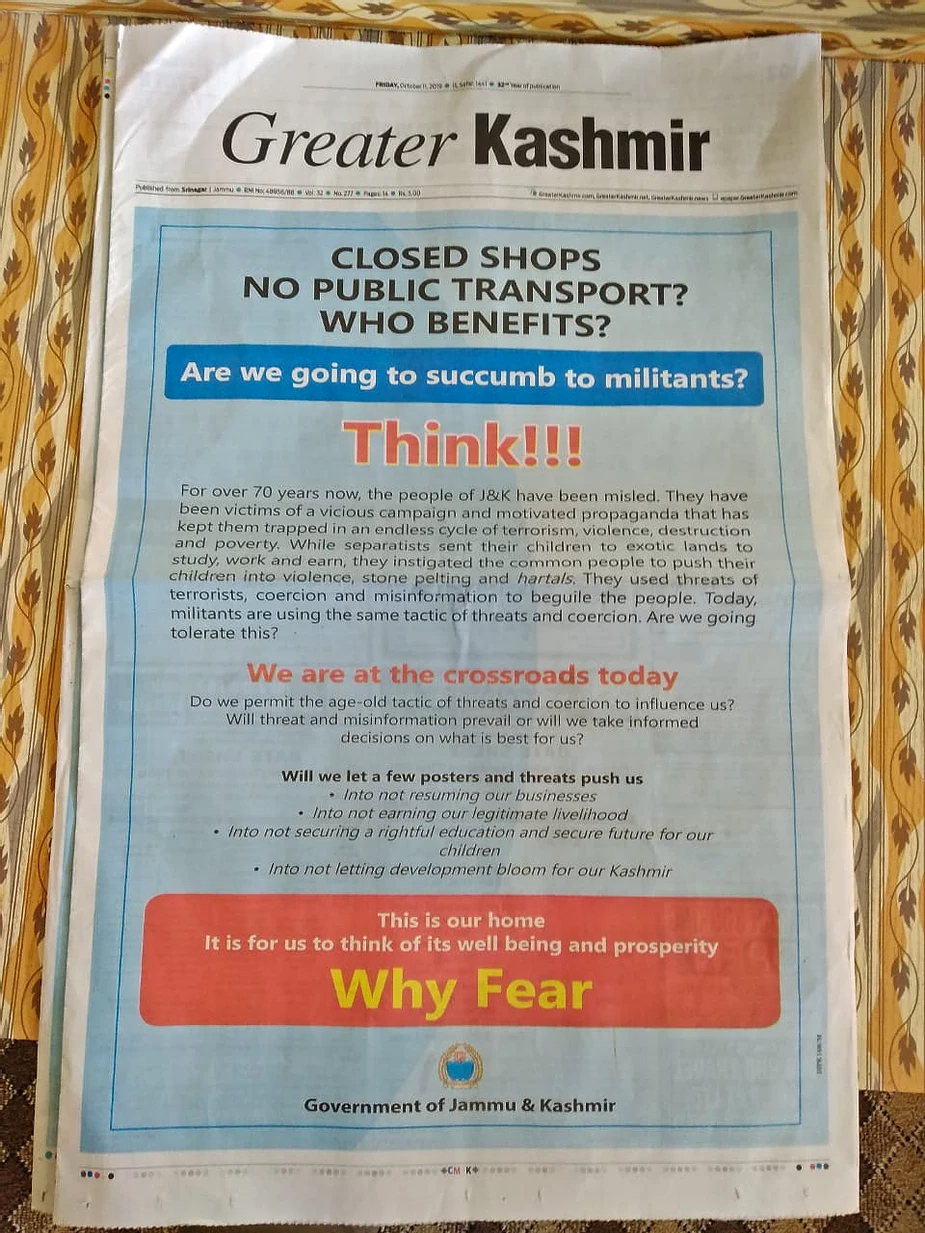
Now it’s virtually impossible to find narratives of suffering in mainstream newspapers. “The news stories are mostly about what police said, what officials said. The people are missing. You won’t see people in the stories,” said Zargar.
If the ordeal of reporting the biggest story of their lives in the midst of a media blackout and a military siege was difficult for Kashmiri journalists, one year later, those early troubles seem almost basic compared to their reporting lives now.
What’s Happening Now
Zargar said “granular, detailed reporting at the local level” has been worst hit.
“They want to curb the space. The clerics in mosques are not saying anything, mainstream politicians are not saying anything, the Hurriyat and the Jamaat-e-Islami have been banned. All spaces engaged with society have been crippled.”
As the big local newspapers cower under the institutionalised harassment, steering clear of “sensitive” topics such as the impact of Art 370 and the subsequent tweaks to law that many believe are aimed at changing the demographic of what was until last year India’s only Muslim majority state, some beacons of independent media must bear the disproportionate weight of keeping track of human rights violations and assorted other daily ignominies.
“A police officer told me there are a lot of people who are happy in the Kashmir media. They don’t want you to report what you are reporting, you are making them uncomfortable,” said Shah, the editor of The Kashmir Walla.
After 5 August when people met Shah they would often joke: “You’re still outside? You haven’t been detained yet?”
Shah said the stories they break now often don’t see any follow-up from the local mainstream media, such as the one about the Kashmir Police summoning Twitter users who share their political opinions or the story about a violent raid on a Budgam village that everyone ignored until videos of the incident went viral.
Umer Asif’s photo for The Kashmir Walla of a teenage mourner, his face riddled with pellet gun injuries, lying with his eyes closed, went viral—underlying the importance of being on the spot.
In this piece about how social media users responded to the missing coverage of the Muharram violence, The Telegraph newspaper described Kashmiri newspapers as “government bulletins”.
In another exclusive story about the police investigation into the killing of three men in Shopian whose families claimed their sons were not militants and had just travelled to work as labourers, Shopian’s Senior Superintendent of Police Amritpal Singh is quoted as threatening the reporter with an FIR claiming that officials of the CFSL (Central Forensic Science Laboratory) Chandigarh had complained of “receiving calls from the press repeatedly”.
Zargar and Masood separately told Article 14 that about the time they visited Handwara in northern Kashmir on 23 December 2019. A member of the Jaamat-e-Islami, had died in custody in an Agra jail and the two journalists decided to visit his family. They were stopped at a police checkpoint outside the village and escorted to meet the local Superintendent of Police (SP). The police were expecting them. “There is complete surveillance of journalists. They knew why I had come,” said Masood.
The conversation with the SP began normally but went rapidly downhill. “Aap yahan pe trigger dene aaye ho (Have you come here to start something)?” asked the police officer, accusing them of coming to the village in search of something that would “trigger” the pent up anger and resentment of Kashmiri people.

The Case of Qazi Shibli
Bane hain ahl e hawas muddai bhi munsif bhi
Kise vakeel karein, kis se munsifi chahein
(People of greed are both the complainant and the judge here
Who’d be our counsel, and from whom we expect justice)
Shibli, editor and founder of news website The Kashmiriyat, has been working from home since he was released from an Uttar Pradesh jail in April where he spent 9 months charged under the Public Safety Act (PSA), 1978. The draconian 42-year old law allows detention without procedure. In December 2019, while in jail, he featured on Time magazine’s 10 ‘Most Urgent Threats To Press Freedom list.
“As a journalist, I live in a zone where everyone has a story,” Shibli told Article 14 over the phone. “People tell us stories because they trust us, they expect us to narrate their stories. If I distort their stories or don’t tell them, it shatters the hopes of many people.”
This past year Shibli’s own story has competed with the stories he feels duty-bound to tell. After his imprisonment, The Kashmiriyat has gained 13-14 interns from other parts of India, many of whom wanted to work with him.
A year after his last arrest, Shibli was detained again for 18 days on 31 July 2020, the day before Eid, under preventive-detention sections 107 and 151 of the Code of Criminal Procedure 1973. “Can you imagine the intimidation we feel?” he said. “At least give us the little joy we feel every Eid.”
It’s easy to understand why Shibli remains under police surveillance. Unlike most journalists who are based in Srinagar, Shibli, whose father was the Mirwaiz of south Kashmir, works out of Anantnag in southern Kashmir, considered a hotbed of militancy. That also means he often gets to the story first; it’s also why The Kashmiriyat gathered 200,000 social-media followers within eight months of its launch, though most of their social-media accounts were later deleted by the authorities.
“My idea always has been, you get these things out first, national and international media just picks it up. Small-town journalists who do the groundwork get the stories for us,” he said. “They want to create an atmosphere of intimidation and fear. We are among few journalists left who want to break the government’s narrative.”
“They’ve polarised the public of the nation into nationalists and anti-nationals. They’ve divided us into good journalists who follow their line and bad journalists who don’t.”
How Reporting The Facts Can Play Out
“A story will lead you inside jail. I think 10 times before filing a story. What could be the consequences? Is the story worth the risk I’m taking, so definitely you miss many stories,” said Indian Express’ Masood.
“Whenever I get a normal story against anyone I have to ensure it’s 100 percent foolproof,” he added. After he wrote this story on the undertaking the Valley’s inhabitants had to give before they could access the Internet, he was questioned by authorities. The official only left him alone when Masood showed him government documents submitted in the Supreme Court that backed what he had reported.
“If we can do this with one woman, we can do it with anyone,” said Nabi. “Even facts don’t go down well with the government. You never know which paragraph, which sentence will put you under threat.”
She listed some practical tips: “I always use ‘might’ even if I’m sure, even if I have the documents.” She texts or emails officials and maintains logs. “Initially I never recorded conversations, now I do.”
Thus far, Shah has managed to hold fast against requests from security agencies to pull down published stories but he lives under constant threat. “People keep telling me ‘I heard this about you’ ‘I heard you’re getting arrested,” he said. “It’s traumatic…you don’t know which is wrong and which is actual information.”
The past few months, when he stepped out of his office to smoke in a garden, his team would ask him not to sit outside. “They have this fear that somebody will come and do something,” said Shah “This is Kashmir, people get killed for nothing.” Even an unknown car parked outside his home causes anxiety.
“Killing and dying is the easiest job in Kashmir,” said Qazi Shibli, who revealed an intelligence officer once threatened to kill him in a fake encounter.
As Masood put it, “I have been trying to be bold…Every day you have a sense of guilt that there is this story and you cannot do it. You reach a level where you just feel disgusted with everything.”




